外研版英语七年级上册第1单元备课参考
2022年外研版七年级上册Module 1 精品教案

七年级上module 1教案Ⅰ.课堂导入PART1 词汇Ⅱ.同步讲解一、词汇点睛1Chinesen.中国人;汉语adj. 中国的, 中国人的I'm Chinese.His friend Kate can speak some Chinese.Li Na is a Chinese girl.[探究] Chinese作可数名词时, 意为“中国人〞, 单复数相同;作不可数名词时, 意为“汉语〞;作形容词时, 常用来修饰__名_词.[拓展] China 用作名词, 意为“中国〞, 注意:表示国家、语言、某个国家的人的名词是专有名词, 其第一个字母要大写. china用作名词, 还可译为“瓷器〞, 这时其第一个字母不要大写.活学活用Daming and Lingling are from China and they are Chinese. (China)2fromprep.从……来, 来自—Where are you from?=Where do you come from?—I'm from Beijing.=I come from Beijing.[探究] from常与be动词连用, 构成短语be from, 表示“来自……〞, 后跟表示地点的名词. 句型“where+be +主语+from?〞常用来询问某人的国籍、故土等.[拓展] come from与be from同义, 可以互换使用.活学活用“你的英语老师来自哪里?〞“她来自上海. 〞—where is your English teacher from?—She is from Shanghai.3yearn.年龄;年I'm thirteen years old.John is one year old and his sister is six years old.[探究] year作“年龄〞讲时, 常用“数字+year〔s〕+old〞表示“……岁〞, 数字大于1时, year的词尾要加s, 变为years.[注意] year(s) old也可以省略, 只用数字表示年龄.[拓展] 对年龄提问要用how old.活学活用“那个男孩几岁?〞“他5岁. 〞—How old is the boy?—He is five.4.Everyone pron. 大家;每人Hello, everyone. 大家好.Everyone in our class is in the classroom.我们班上的每个人都在教室里.[探究] everyone为代词, 只能用来指人, 其意思相当于everybody. everyone作主语时, 谓语动词用___单数形式.活学活用Everyone in the class likes (like) playing basketball.5.firstadj. 第一(位)的, 首要的adv. 先;首先Here is the first map. 这是第一张地图.First, I'd like to thank you for coming.首先, 我要感谢你们的光临.[探究] first作形容词时, 通常与定冠词_the_______连用;first作副词时, 通常放在句子的___开头_____, 且用逗号隔开.[拓展] (1)first的对应词为last. first还可用作基数词one的序数词形式, 意为“第一的〞, 表示顺序.(2)序数词前面有形容词性物主代词修饰时, 其前不加定冠词the. 例如:My first teacher in the primary school is Mr Chen. He teaches us Chinese and maths. 我小学的启蒙老师是陈老师. 他教我们语文和数学.活学活用(1)Miss Li is our ________ English teacher.A.a B.anC.one D.first(2)Liu Changchun is ________ first Chinese to join the Olympics.A.a B.anC.the D./6.All pron. 每个, 全体It's nice to meet you all. 很快乐见到你们所有人.All of the students are here. 全体学生都在这里.All of us are busy working. 我们所有人都忙于工作.[探究] all用作代词, 意为“每个;全体〞, 指三者或三者_以上_____ 都, 可单独使用, 也可用“all of+the_ 可数名词的复数_或代词的宾格〞.[拓展] (1)all 还可用作形容词, 意为“所有的;全部的〞, 其后可接可数名词复数, 也可接不可数名词, 如all the children/time等.(2)all还可用作副词, 意为“都〞, 常用在be动词或助动词之后, 行为动词之前. 例如:We are all in the classroom. We all study hard.我们都在教室里. 我们都在努力学习.活学活用我非常伤心. 我的所有玩具都坏了.I'm very sad. ____All of____________ my toys are broken.It's very happy to play (play) football with you.PART2 句子与语法1-E2-C3-A4-B5-D句型1.Hello, what about you? 你好, 你呢?What about…?意为“……怎么样?〞相当于“How about…?〞, 常用来询问他人的情况, 其后接名词、代词或动名词.例如:What about an apple, Tom?I'm twelve years old.What about you, Lucy?It's very hot today.What about going swimming?活学活用—Today is fine. What about________ a picnic?—That's a good idea. Let's go.A.have B. to haveC.having D.HasC2.What’s your name?英语中,当想知道对方叫什么名字时,可用句型"What’s your name? "进行询问,其答语一般用"My name is+姓名.".—What’s your name?—My name’s Gao Jing.3.I’m twelve years old...years old, 表示“...岁〞. 有时候years old 可以省略, 只用数字来表达年龄即可. 如:Her dog is three.对该句型提问可用:How old ...? 它是英语中一个较重要的句型,主要用来询问某人的年龄,其答语通常用"主语+ am / is / are + 年龄.--How old are you?--I am thirteen (years old).活学活用--How old are you?--I am .A.ten B. Susan C.nice D.Class4A4.Nice to meet you用于第一次见面时说的话, 一般的场合都可以. 比较正式.--Nice to meet you--Nice to meet you, too.语法一、人称代词1.用来代替上文提到的人或物的代词称为人称代词. 人称代词又分为主格和宾格两种. 如下表:2.主格代词在句中作主语, 常置于句首;宾格代词在句中作宾语, 常放在动词或介词后面.活学活用用适当的人称代词填空1.Hi, ________ am Wang Nana.2.This girl is my friend. ________ is 10 years old.3.That boy is from England. ________ is Jack.4.—Are ________ from Class One, Lucy?—Yes, ________ am.5.This is our teacher, Mr Zhang. ________ is 36 years old.1. I2. She3. He4. you; I5. He二、be动词的一般现在时1.be动词的含义及用法am/is/are是动词be的一般现在时形式, 根本意思为“是〞, 用来说明年龄、身份、状态等.2.一般现在时的根本用法:(1)肯定句式:主语+am/is/are +其他.例如:I am a student.我是一名学生.He's a doctor.他是一位医生.It's a desk.它是一张桌子.They are my friends. 他们是我的朋友.(2)否认句式:________+________+________+其他.(注意:is, are可与not缩写为isn't, aren't, 但am 不可与not缩写) 主语;am/is/are; not(3)一般疑问句句式:________+________+其他?Am/Is/Are; 主语;肯定答复:________, 主语+be(am/is/are).Yes;否认答复:No, 主语+be(am/is/are)+not.例如:—Is this a map? 这是一张地图吗?—Yes, it is.是的, 它是.—Are they from Xinjiang? 他们来自新疆吗?—No, they aren't.不, 他们不是.【温馨提示】肯定答复中的be动词不能与前面的代词缩写;否认答复中的not可以与前面的be动词缩写, 但am不能与not缩写.[口诀] 我(I)用am, 你(you)用are, is 连接他(he)、她(she)、它(it). 单数词用is, 复数词全用are.活学活用用be动词的适当形式填空1.I ________ from Jinan, the capital of Shandong.2.________ you a teacher?3.My friend ________ in Class 1.4.Lucy and Lily ________ twins.5.This ________ an interesting story. I like it very much.1. am2. Are3. is4. are5. is稳固训练单项选择:(C)1.-Nice to meet you.- .A.Good morningB.You are welcomeC.Nice to meet you,tooD.Goodbye(C)2.He from Beijing,I from Shanghai.A.i s isB. am amC. is amD. is comes(B)3.A panda ____________ from China.A.amB. isC. are(A)4. It’s nice ______________my old friends here.A. to meetB.meetC. meetsPART3 课后稳固一、完形填空:〔10分〕My name is Nancy. I’m twelve __1__old. I’m __2__England. I’m a middle school student. I’m in Class__3__. I like green and blue. This__4__my new friend. Her__5__ is Wendy. She is thirteen. She is from__6__too. We are friends, __7__we are in different〔不同的〕classes. Wendy is in Class Four. She__8__red and yellow. Wendy likes __9__too, but I can’t swim. On sundays, we often __10__together.( B ) 1.A. year B. years C. /( A ) 2.A. from B. in C. on( A ) 3.A. four B. Three C. Two( A ) 4.A.is B. are C. am( A ) 5.A. name B. names C. name’s( C ) 6.A. English B. America C. England( C ) 7.A. and B. so C. but( A ) 8.A. likes B. like C. is( C ) 9.A. basketball B. football C. swimming( A ) 10.A. play B. playing C. plays二、判断正误:正确的写A, 错误的写B.〔10分〕My name is Felix Black. I am from America. I’m twelve years old. And I am a student in No.2 Middle School in Suzhou. Mrs Zhao is our Chinese teacher. My friend is also a student here. Her name is Maria Smith. She is from England. She is thirteen years old. Maria and I are new students in No. 2 Middle School. We like our Chinese class.( B )1.Felix is thirteen years old.( A )2.Mr Zhao is Felix’s Chinese teacher.( A )3.Maria is from England.( A )4.Felix and Maria are in the same〔同样的〕school.( B )5.They do n’t like their Chinese class.三、书面表达:〔10 分〕根据以下信息用英语写一篇介绍自己及好朋友的短文,可自由发挥.I My friendName Panpan TongtongAge 12 13City Wuhan QingdaoClass 3 6活学活用—Today is fine. What about________ a picnic?—That's a good idea. Let's go.A.have B. to haveC.having D.HasC2.What’s your name?英语中,当想知道对方叫什么名字时,可用句型"What’s your name? "进行询问,其答语一般用"My name is+姓名.".—What’s your name?—My name’s Gao Jing.3.I’m twelve years old...years old, 表示“...岁〞. 有时候years old 可以省略, 只用数字来表达年龄即可. 如:Her dog is three.对该句型提问可用:How old ...? 它是英语中一个较重要的句型,主要用来询问某人的年龄,其答语通常用"主语+ am / is / are + 年龄.--How old are you?--I am thirteen (years old).活学活用--How old are you?--I am .B.ten B. Susan C.nice D.Class4A4.Nice to meet you用于第一次见面时说的话, 一般的场合都可以. 比较正式.--Nice to meet you--Nice to meet you, too.语法一、人称代词1.用来代替上文提到的人或物的代词称为人称代词. 人称代词又分为主格和宾格两种. 如下表:2.主格代词在句中作主语, 常置于句首;宾格代词在句中作宾语, 常放在动词或介词后面.活学活用用适当的人称代词填空1.Hi, ________ am Wang Nana.2.This girl is my friend. ________ is 10 years old.3.That boy is from England. ________ is Jack.4.—Are ________ from Class One, Lucy?—Yes, ________ am.5.This is our teacher, Mr Zhang. ________ is 36 years old.1. I2. She3. He4. you; I5. He二、be动词的一般现在时1.be动词的含义及用法am/is/are是动词be的一般现在时形式, 根本意思为“是〞, 用来说明年龄、身份、状态等.2.一般现在时的根本用法:(1)肯定句式:主语+am/is/are +其他.例如:I am a student.我是一名学生.He's a doctor.他是一位医生.It's a desk.它是一张桌子.They are my friends. 他们是我的朋友.(2)否认句式:________+________+________+其他.(注意:is, are可与not缩写为isn't, aren't, 但am 不可与not缩写) 主语;am/is/are; not(3)一般疑问句句式:________+________+其他?Am/Is/Are; 主语;肯定答复:________, 主语+be(am/is/are).Yes;否认答复:No, 主语+be(am/is/are)+not.例如:—Is this a map? 这是一张地图吗?—Yes, it is.是的, 它是.—Are they from Xinjiang? 他们来自新疆吗?—No, they aren't.不, 他们不是.【温馨提示】肯定答复中的be动词不能与前面的代词缩写;否认答复中的not可以与前面的be动词缩写, 但am不能与not缩写.[口诀] 我(I)用am, 你(you)用are, is 连接他(he)、她(she)、它(it). 单数词用is, 复数词全用are.活学活用用be动词的适当形式填空1.I ________ from Jinan, the capital of Shandong.2.________ you a teacher?3.My friend ________ in Class 1.4.Lucy and Lily ________ twins.5.This ________ an interesting story. I like it very much.1. am2. Are3. is4. are5. is稳固训练单项选择:(C)1.-Nice to meet you.- .A.Good morningB.You are welcomeC.Nice to meet you,tooD.Goodbye(C)2.He from Beijing,I from Shanghai.B.is is B. am amC. is amD. is comes(B)3.A panda ____________ from China.A.amB. isC. are(A)4. It’s nice ______________my old friends here.A. to meetB.meetC. meetsPART3 课后稳固一、完形填空:〔10分〕My name is Nancy. I’m twelve __1__old. I’m __2__England. I’m a middle school student. I’m in Class__3__. I like green and blue. This__4__my new friend. Her__5__ is Wendy. She is thirteen. She is from__6__too. We are friends, __7__we are in different〔不同的〕classes. Wendy is in Class Four. She__8__red and yellow. Wendy likes __9__too, but I can’t swim. On sundays, we often __10__together.( B ) 1.A. year B. years C. /( A ) 2.A. from B. in C. on( A ) 3.A. four B. Three C. Two( A ) 4.A.is B. are C. am( A ) 5.A. name B. names C. name’s( C ) 6.A. English B. America C. England( C ) 7.A. and B. so C. but( A ) 8.A. likes B. like C. is( C ) 9.A. basketball B. football C. swimming( A ) 10.A. play B. playing C. plays二、判断正误:正确的写A, 错误的写B.〔10分〕My name is Felix Black. I am from America. I’m twelve years old. And I am a student in No.2 Middle School in Suzhou. Mrs Zhao is our Chinese teacher. My friend is also a student here. Her name is Maria Smith. She is from England. She is thirteen years old. Maria and I are new students in No. 2 Middle School. We like our Chinese class.( B )1.Felix is thirteen years old.( A )2.Mr Zhao is Felix’s Chinese teacher.( A )3.Maria is from England.( A )4.Felix and Maria are in the same〔同样的〕school.( B )5.They do n’t like their Chinese class.三、书面表达:〔10 分〕根据以下信息用英语写一篇介绍自己及好朋友的短文,可自由发挥.I My friendName Panpan TongtongAge 12 13City Wuhan QingdaoClass 3 6。
七年级英语上册 Module 1 Unit 1 The first English lesson教案 外研版

M M o o d d u u l l e e11N N i i c c e e t t o o m m e e e e t t y y o o u u Unit 1 The first English lesson一、教学目标:1.知识与技能:Vocabulary:first, lesson, class, student, Miss, blackboard, open, close, match, write, read, listen, practice, eleven, twelve, thirteen, twenty-nine, fifty Pronunciation:/i:/ /i/ /e/ /æ /2.过程与方法:Character building:Motivate students’ interest in learning English. Make friends with all students.3.情感态度与价值观:Self study and Cooperate study二、教学重点、难点Ss try to get information from the reading materials, and answer some questions.三、教学方法:Listening and speaking四、教学手段与教学媒体:Interactive approachTape recorder, video, OHP五、课时安排:1.1六、教学过程:Step 1 (warm up)Introduction . Using these ways.My Chinese name is ShenJinhu. My English name is Jane. I’m an English teacher. You can call me Mr.Shen. I’m 33 years old. I’m from Tianjin, China. I’m Chinese. I teach in Tianjin Experimental Junior Middle School. You’re my students. We’re good friends.Step 2:Ask students to introduce themselves with this pattern.Remember these language points:1) My Chinese / English name is…2) I’m a student.3) I’m …years old.4) I’m from…5) I study in Tianjin Experimental Junior Middle School.6) We’re your students.7) We’re good friends, too.Step 3:Listen to the conversation of Activity 3. Ask students to listen without opening their books. Then answer myquestions.Q1:What’s the teacher’s family name?Q2: Where’s she from?Q3: Is she Chinese or English?Q4: What’s the first girl’s name?Q5: Where’s she from?Q6: What’s the boy’s name?Q7: Is he from Beijing, too?Q8: How old are Lingling and Daming?Q9: What’s the second boy’s name?Q10: Where’s he from?Step 4:Ask students to retell the conversation and create anew one with their own real life.Step 5:Do listening of Activity 1 and Activity 6.Step 6:Do writing with the words of Activity 2.I can show them a model before writing. After writing, I’llread the good ones to the students in order to encourage themto write more. After that, ask students to evaluate whosewriting is the best, etc.Hello, class! I’m your English teacher. I’m Chinese. You can call me Miss Xie. You are my students. I hope we’re friends in the school. All the teachers are kind. They are as good asyour father and mother.Step 7:Learn, watch and do the actions about the words ofActivity 8.七、板书:The new words:Chinese, class, father, friend, mother, student, teacherThe drills:1) My Chinese / English name is…2) I’m a student.3) I’m …ye ars old.4) I’m from…5) I study in Tianjin Experimental Junior Middle School.6) We’re your students.7) We’re good friends, too.八、课后反思:When we learn this part, we should ask students to relax. This is an easy time and play the game with Bingo.。
外研版七年级英语上册教案Module 1 Unit 1 Nice to meet you
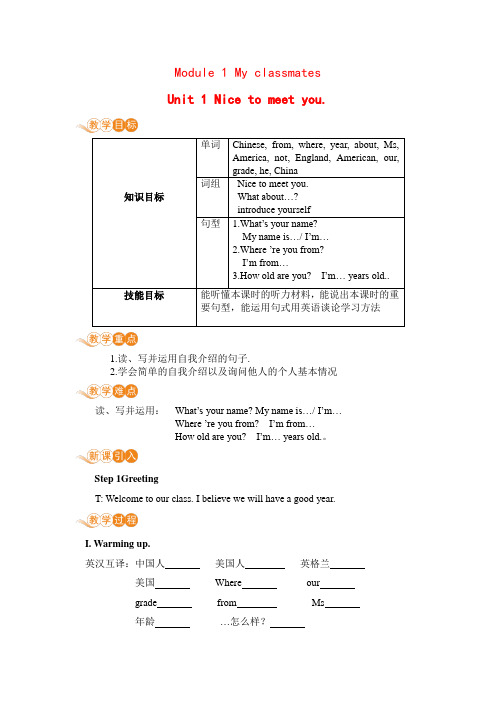
Module 1 My classmatesUnit 1 Nice to meet you.知识目标 单词 Chinese, from, where, year, about, Ms, America, not, England, American, our, grade, he, China 词组 Nice to meet you.What about…?introduce yourself句型 1.What’s your name?My name is…/ I’m…2.Where ’re you from?I’m from…3.How old are you? I’m… years old..技能目标能听懂本课时的听力材料,能说出本课时的重要句型,能运用句式用英语谈论学习方法1.读、写并运用自我介绍的句子.2.学会简单的自我介绍以及询问他人的个人基本情况读、写并运用: What’s your name? My name is…/ I’m…Where ’re you from? I’m from…How old are you? I’m… years old.。
Step 1GreetingT: Welcome to our class. I believe we will have a good year.I. Warming up. 英汉互译:中国人 美国人 英格兰美国Where ourgrade from Ms年龄 …怎么样?A chantNice to meet you! Nice to meet you! My dear friend!Nice to meet you! Nice to meet you! My dear classmate!Nice to meet you! Nice to meet you! My dear desk mate!II. Step II Pre-Listening: A1 and A2Step III While-listeningTask 1 Close the book, Listen and answer:(1)How many people are there in the dialogue?_______________________(2)How old is Daming? _________________________Task 2 Open the book and read after the tapeTip:Pay attention to the pronunciation and intonation.Step IV Post-listeningTask1 Read the dialogue in roles or in groups.Task 2 Activity3. Check the true sentences.Task 3 Ask a few groups to stand in front of the class and act it outTip: Encourage the students to be active.Step V DevelopmentTask 1 Finish Activity 4&5.Correct the answers in groups.Task 2 Ask and answer in pairs (运用学习目标中的句子)Step VI Summary回顾教学目标中的内容,说一说这一节课你学到的知识。
外研版七年级英语上册《Module1Unit1Goodmorning,MissZhou》教案
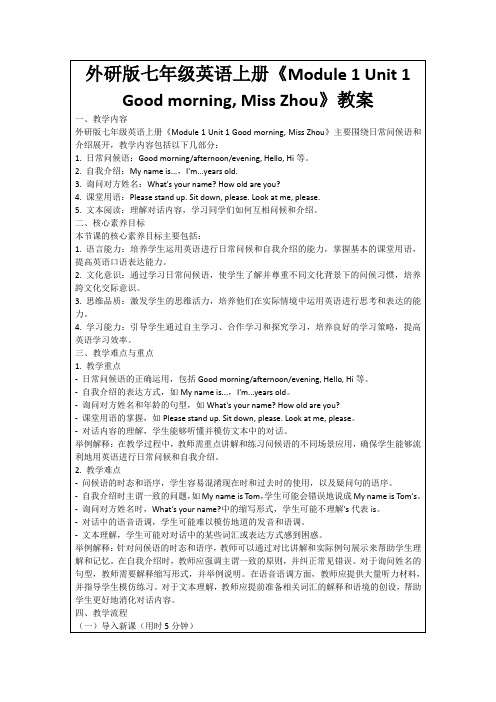
1.理论介绍:首先,我们要了解日常英语问候的基本概念。问候语是日常交流中的重要组成部分,它能够拉近人与人之间的距离。在英语中,不同的时间有不同的问候语,如Good morning/afternoon/evening。
2.案例分析:接下来,我们来看一个具体的案例。文本中的对话展示了同学们如何用英语互相问候和自我介绍,以及如何在课堂上使用基本的英语指令。
此外,在总结回顾环节,虽然学生们普遍表示掌握了本节课的知识点,但我也发现他们在实际运用中仍存在一些问题。因此,我计划在下一节课开始前,对学生进行一次简短的小测验,以检验他们对于问候语和自我介绍的实际掌握情况。
外研版七年级英语上册《Module 1 Unit 1 Good morning, Miss Zhou》教案
一、教学内容
外研版七年级英语上册《Module 1 Unit 1 Good morning, Miss Zhou》主要围绕日常问候语和介绍展开,教学内容包括以下几部分:
1.日常问候语:Good morning/afternoon/evening, Hello, Hi等。
3.成果展示:每个小组将向全班展示他们的讨论成果和角色扮演的结果。
(四)学生小组讨论(用时10分钟)
1.讨论主题:学生将围绕“英语问候语在实际生活中的应用”这一主题展开讨论。他们将被鼓励提出自己的观点和想法,并与其他小组成员进行交流。
2.引导与启发:在讨论过程中,我将作为一个引导者,帮助学生发现问题、分析问题并解决问题。我会提出一些开放性的问题来启发他们的思考。
4.学习能力:引导学生通过自主学习、合作学习和探究学习,培养良好的学习策略,提高英语学习效率。
三、教学难点与重点
1.教学重点
外研版初一英语七年级上册Module 1单元教案(全套)
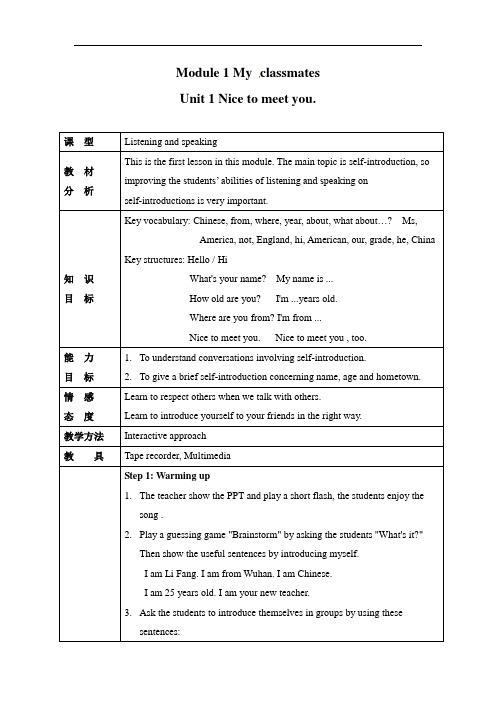
Module 1 My classmatesUnit 1 Nice to meet you. 课型Listening and speaking教材分析This is the first lesson in this module. The main topic is self-introduction, so improving the students’ abilities of listening and speaking onself-introductions is very important.知识目标Key vocabulary: Chinese, from, where, year, about, what about…? Ms,America, not, England, hi, American, our, grade, he, China Key structures: Hello / HiWhat's your name? My name is ...How old are you? I'm ...years old.Where are you from? I'm from ...Nice to meet you. Nice to meet you , too.能力目标1.To understand conversations involving self-introduction.2.To give a brief self-introduction concerning name, age and hometown.情感态度Learn to respect others when we talk with others.Learn to introduce yourself to your friends in the right way.教学方法Interactive approach教具Tape recorder, MultimediaStep 1: Warming up1.The teacher show the PPT and play a short flash, the students enjoy thesong .2.Play a guessing game "Brainstorm" by asking the students "What's it?"Then show the useful sentences by introducing myself.I am Li Fang. I am from Wuhan. I am Chinese.I am 25 years old. I am your new teacher.3.Ask the students to introduce themselves in groups by using thesesentences:教学过程教学过程What's your name? Where are you from?How old are you? Which class are you in?Nice to meet you.Step 2: Listening1.Play the recording in activity 1 and ask the students to listen and checkhow many people speak.2.Play it again and ask the students to check the words their hear.3.Check the answers with the whole students.Step 3: Listen and read1.Play the recording in activity 3 and ask the students to listenand answer the questions. Then check the answers.(1) How many people speak in the conversation?(2) Who are they?(3) Are they in the same class?2.Play it again and check the true sentences in act3. Ask somestudents to correct the wrong ones.3. Put the students into groups of four to practise the dialogue.The students repeat it several times, changing roles each time.4.Talk about the pictures in the PPT and show their performances.5.Ask the students to sum up the useful sentences in the dialogue andintroduce “Everyday English.”6.Finish act 4 and 5 in groups. Teacher checks the answers.Step 4: Pronunciation1.Explain that this activity focuses on some English phonemes which aredifficult to pronounce for speakers of Chinese.2.Play the recording once without stopping.教学过程3.Play it again and ask the students to repeat.4.Practise the sounds in pairs, then finish the exercises on the PPT.Step 5: Speaking1.Talk about the pictures by asking and answer in paris like this:A: What’s his name?B: His name is….A: Where is he from?B: He's from….A: How old is he?B: He's ...years old.Step 6: Module taskTask 1: Who has the most friends?运用本课句型,在规定的八分钟时间内,以小组为单位,看谁结交的朋友最多,她将获得一份丰厚的奖品。
外研版七年级英语上册《 Unit 1 There are thirty students in my class.》精品教案_2
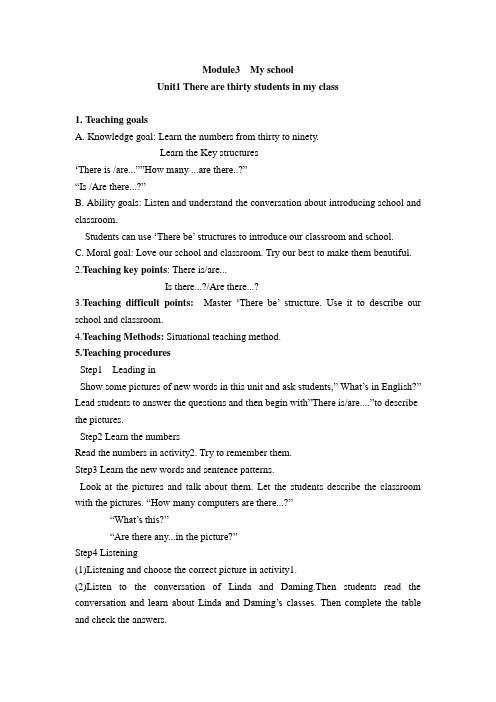
Module3 My schoolUnit1 There are thirty students in my class1.Teaching goalsA.Knowledge goal: Learn the numbers from thirty to ninety.Learn the Key structures‘There is /are...””How many ...are there..?”“Is /Are there...?”B. Ability goals: Listen and understand the conversation about introducing school and classroom.Students can use ‘There be’ structures to introduce our classroom and school.C. Moral goal: Love our school and classroom. Try our best to make them beautiful.2.Teaching key points: There is/are...Is there...?/Are there...?3.Teaching difficult points: Master ‘There be’ structure. Use it to describe our school and classroom.4.Teaching Methods: Situational teaching method.5.Teaching proceduresStep1 Leading inShow some pictures of new words in this unit a nd ask students,”What’s in English?” Lead students to answer the questions and then begin with”There is/are....”to describe the pictures.Step2 Learn the numbersRead the numbers in activity2. Try to remember them.Step3 Learn the new words and sentence patterns.Look at the pictures and talk about them. Let the students describe the classroom with the pictures. “How many computers are there...?”“What’s this?”“Are there any...in the picture?”Step4 Listening(1)Listening and choose the correct picture in activity1.(2)Listen to the conversation of Linda and Daming.Then students read the conversation and learn about Linda and Daming’s classes. Then complete the table and check the answers.(3)Ask students read the conversation in pairs .Step 5 Role-play1.Role play in pairs.2.Role play in front of the class.Step6 PairworkWork in pairs to describe our ideal classroom, using the sentences,”How many... Are there in your classroom?” ‘There are...” “Is there a ...?” “Yes, there is /No, there isn’t” “Are there..?””Yes, there are/No, there aren’t.Step6 Sum upLet students sum up the key words and the sentence patterns by themselves.Step 7 Homework(1) Review the new words and expressions.(2)Introduce your bedroom to your partner.Step 8 Preview1.Preview the new words and expressions in unit2.2.Draw a map of your school.Blackboard designUnit1 There are thirty students in my classcomputer, television, furniture, wall, map.How many...are there?There is a lot of furnitureThere are some...Are there...?\Is there...?。
外研版英语七年级上册第1单元备课参考
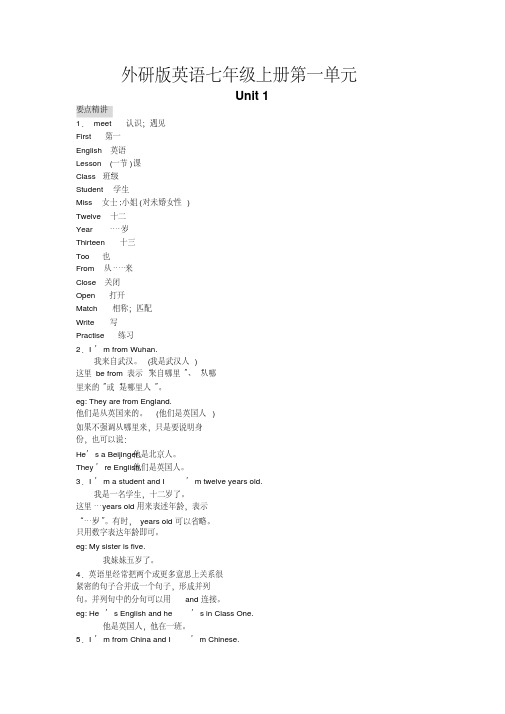
外研版英语七年级上册第一单元Unit 1要点精讲1.meet 认识;遇见First 第一English 英语Lesson (一节)课Class 班级Student 学生Miss 女士;小姐(对未婚女性)Twelve 十二Year ……岁Thirteen 十三Too 也From 从……来Close 关闭Open 打开Match 相称;匹配Write 写Practise 练习2.I’m from Wuhan.我来自武汉。
(我是武汉人)这里be from表示“来自哪里”、“从哪里来的”或“是哪里人”。
eg: They are from England.他们是从英国来的。
(他们是英国人)如果不强调从哪里来,只是要说明身份,也可以说:He’s a Beijinger.他是北京人。
他们是英国人。
They’re English.3.I’m a student and I’m twelve years old.我是一名学生,十二岁了。
这里…years old 用来表述年龄,表示“……岁”。
有时,years old可以省略。
只用数字表达年龄即可。
eg: My sister is five.我妹妹五岁了。
4.英语里经常把两个或更多意思上关系很紧密的句子合并成一个句子,形成并列句。
并列句中的分句可以用and连接。
eg: He’s English and he’s in Class One.他是英国人,他在一班。
5.I’m from China and I’m Chinese.我来自中国,我是中国人。
在表达来自某个国家时,要使用国名。
如:China, Canada等等。
如果要强调是某国人时,则要用其形容词形式。
如:Chinese, English等等。
另:be from=come fromeg: Tom is from America.=Tom comesfrom America.汤姆来自美国。
典型例题【例1】---Hi, Tony. -----______.A.How are you?B.Good afternoon,Frank.C.Hi, Bob.D.Good morning,Kate.【答案】C【解析】Hi是问候语的标志,根据上下句,“Hi, Tony”是见面打招呼的用语,那么答句也与之相同【例2】----This is ______ Li, he is my English teacher.A.MrB.MrsC.MsD. Miss【答案】A【解析】根据句中的“he”,可以知道李老师是男性,称呼男性应用“Mr”。
外研版七年级英语上册外研版《Starter Module 1 Unit 1 Goodmorning,
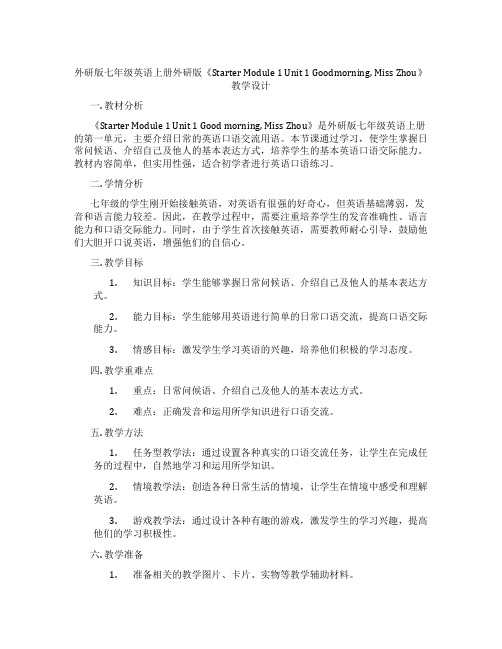
外研版七年级英语上册外研版《Starter Module 1 Unit 1 Goodmorning, Miss Zhou》教学设计一. 教材分析《Starter Module 1 Unit 1 Good morning, Miss Zhou》是外研版七年级英语上册的第一单元,主要介绍日常的英语口语交流用语。
本节课通过学习,使学生掌握日常问候语、介绍自己及他人的基本表达方式,培养学生的基本英语口语交际能力。
教材内容简单,但实用性强,适合初学者进行英语口语练习。
二. 学情分析七年级的学生刚开始接触英语,对英语有很强的好奇心,但英语基础薄弱,发音和语言能力较差。
因此,在教学过程中,需要注重培养学生的发音准确性、语言能力和口语交际能力。
同时,由于学生首次接触英语,需要教师耐心引导,鼓励他们大胆开口说英语,增强他们的自信心。
三. 教学目标1.知识目标:学生能够掌握日常问候语、介绍自己及他人的基本表达方式。
2.能力目标:学生能够用英语进行简单的日常口语交流,提高口语交际能力。
3.情感目标:激发学生学习英语的兴趣,培养他们积极的学习态度。
四. 教学重难点1.重点:日常问候语、介绍自己及他人的基本表达方式。
2.难点:正确发音和运用所学知识进行口语交流。
五. 教学方法1.任务型教学法:通过设置各种真实的口语交流任务,让学生在完成任务的过程中,自然地学习和运用所学知识。
2.情境教学法:创造各种日常生活的情境,让学生在情境中感受和理解英语。
3.游戏教学法:通过设计各种有趣的游戏,激发学生的学习兴趣,提高他们的学习积极性。
六. 教学准备1.准备相关的教学图片、卡片、实物等教学辅助材料。
2.准备教学录音机、录音带或多媒体教学课件。
3.准备教材和教师用书。
七. 教学过程1.导入(5分钟)教师用中文与学生进行简单的日常问候,然后引导学生用英语进行问候。
例如:“Good morning, class. How are you?”“Fine, thank you, Mr./Miss…”通过这样的方式,让学生初步感受英语的日常问候语。
七上第一模块单元备课
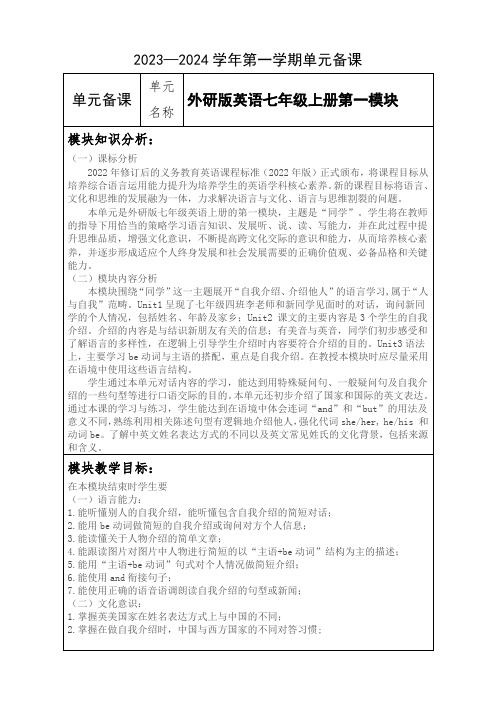
单元备课
单元
名称
外研版英语七年级上册第一模块
模块知识分析:
(一)课标分析
2022年修订后的义务教育英语课程标准(2022年版)正式颁布,将课程目标从培养综合语言运用能力提升为培养学生的英语学科核心素养。新的课程目标将语言、文化和思维的发展融为一体,力求解决语言与文化、语言与思维割裂的问题。
6.能使用and衔接句子;
7.能使用正确的语音语调朗读自我介绍的句型或新闻;
(二)文化意识:
1.掌握英美国家在姓名表达方式上与中国的不同;
2.掌握在做自我介绍时,中国与西方国家的不同对答习惯;
(三)思维品质:
1.培养良好的交际态度,交流时要尊重对方的习惯,令对方感到舒服;
2.掌握做自我介绍的表达方式,结识新朋友,形成新的学习集体并能互相帮助;
学生通过本单元对话内容的学习,能达到用特殊疑问句、一般疑问句及自我介绍的一些句型等进行口语交际的目的。本单元还初步介绍了国家和国际的英文表达。
通过本课的学习与练习,学生能达到在语境中体会连词“and”和“but”的用法及意义不同,熟练利用相关陈述句型有逻辑地介绍他人,强化代词she/her, he/his 和动词be。了解中英文姓名表达方式的不同以及英文常见姓氏的文化背景,包括来源和含义。
2.用特殊疑问句、一般疑问句及自我介绍的一些句型等进行口语交际;
单元教学难点:
be一般现在时(主语为I, they, we, you)的陈述句和疑问形式。
单元教学措施:
1、通过学习课文后,小组总结并检测用法;
2、引导学生自读和查读,造句练习;
3、精细讲解,大量练习,当堂检测;
4、根据学生在英语学习中的困难,利用学过的组成对话形式进行练习。
新外研英语七年级上 Starter 部分 《Module1 Unit1 》教学设计

新外研英语七年级上 Starter 部分《Module1 Unit1 》教学设计一. 教材分析《新外研英语》七年级上册Starter部分《Module1 Unit1》主要介绍了日常生活中的基本问候语和介绍自己的方式。
本单元包括三个主要句子:“Hello, my name is…”“Good morning/afternoon/evening, my name is…”“Nice to meet you.”以及一个常用表达:“How are you?”本单元的教学目标是让学生掌握基本的日常英语问候和自我介绍,并能够运用到实际生活中。
二. 学情分析七年级的学生刚开始接触英语,对于大部分学生来说,英语是一门全新的学科。
因此,学生在学习过程中需要逐步建立对英语的兴趣和信心。
在《Module1 Unit1》的教学中,学生需要掌握基本的日常英语问候和自我介绍,为以后的学习打下基础。
三. 教学目标1.知识目标:学生能够掌握基本的日常英语问候和自我介绍,如“Hello,my name is…”“Good morning/afternoon/evening, my name is…”“Nice to meet you.”以及“How are you?”2.能力目标:学生能够听、说、读、写这些问候和自我介绍的表达,并在实际生活中运用。
3.情感目标:通过学习英语问候和自我介绍,学生能够更加自信地面对新的学习环境,建立良好的同学关系。
四. 教学重难点1.重点:学生能够掌握基本的日常英语问候和自我介绍。
2.难点:学生能够正确地发音和运用这些问候和自我介绍的表达。
五. 教学方法1.任务型教学法:通过设定各种实际情境,让学生在完成任务的过程中运用所学知识。
2.情境教学法:创造真实的语言环境,让学生在实际情境中学习英语。
3.交互式教学法:引导学生相互交流、互动,提高学生的参与度和积极性。
六. 教学准备1.教师准备:熟悉教材内容,了解学生的学习情况,设计教学活动和作业。
外研版七年级英语上册(教学设计)《starter Module1 Unit 1 Goodmornin
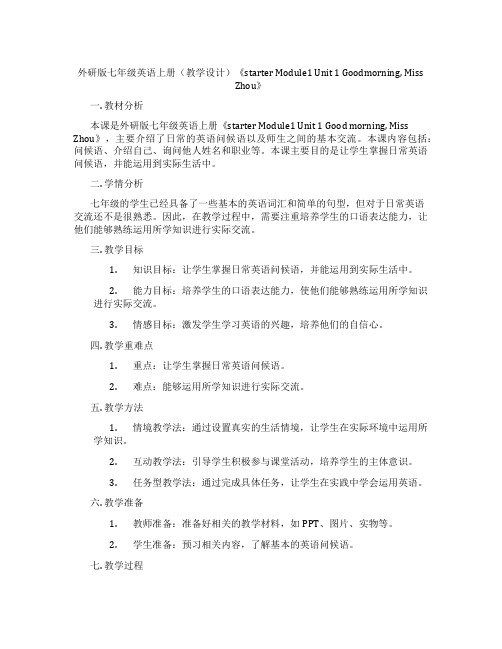
外研版七年级英语上册(教学设计)《starter Module1 Unit 1 Goodmorning, MissZhou》一. 教材分析本课是外研版七年级英语上册《starter Module1 Unit 1 Good morning, Miss Zhou》,主要介绍了日常的英语问候语以及师生之间的基本交流。
本课内容包括:问候语、介绍自己、询问他人姓名和职业等。
本课主要目的是让学生掌握日常英语问候语,并能运用到实际生活中。
二. 学情分析七年级的学生已经具备了一些基本的英语词汇和简单的句型,但对于日常英语交流还不是很熟悉。
因此,在教学过程中,需要注重培养学生的口语表达能力,让他们能够熟练运用所学知识进行实际交流。
三. 教学目标1.知识目标:让学生掌握日常英语问候语,并能运用到实际生活中。
2.能力目标:培养学生的口语表达能力,使他们能够熟练运用所学知识进行实际交流。
3.情感目标:激发学生学习英语的兴趣,培养他们的自信心。
四. 教学重难点1.重点:让学生掌握日常英语问候语。
2.难点:能够运用所学知识进行实际交流。
五. 教学方法1.情境教学法:通过设置真实的生活情境,让学生在实际环境中运用所学知识。
2.互动教学法:引导学生积极参与课堂活动,培养学生的主体意识。
3.任务型教学法:通过完成具体任务,让学生在实践中学会运用英语。
六. 教学准备1.教师准备:准备好相关的教学材料,如PPT、图片、实物等。
2.学生准备:预习相关内容,了解基本的英语问候语。
七. 教学过程1.导入(5分钟)教师通过与学生用中文进行简单的日常问候,引出本课的主题。
然后用PPT展示一些日常英语问候语的图片,让学生猜测其含义。
2.呈现(10分钟)教师通过PPT展示本课的主要内容,包括问候语、介绍自己、询问他人姓名和职业等。
同时,用实物或图片辅助展示,让学生更好地理解。
3.操练(10分钟)教师引导学生进行角色扮演,模拟实际生活中的场景,让学生学会运用所学知识进行交流。
七年级英语上册Module1Myclassmates教案(新版)外研版

4.情境教学:创设真实的语境,如模拟学校新生报到、同学聚会等场景,让学生在具体的情境中进行角色扮演和语言实践。
5.互动环节:利用互动式白板,展示各种外貌特征的人物图片,让学生用所学知识进行描述,提高课堂互动性。
-参考教材中的练习题,进行课后复习和巩固,尤其关注语法和词汇的运用。
-利用网络资源,如英语学习论坛、在线翻译工具等,查找与人物描写相关的资料,拓展知识面。
在拓展与延伸环节,教师要关注学生的个体差异,鼓励他们根据自己的兴趣和需求进行自主学习。同时,教师应定期检查学生的课后学习成果,给予反馈和指导,以提高学生的学习效果。通过这些拓展与延伸活动,学生将更好地掌握本节课的知识点,提高英语实际运用能力。
-示例:
My name is Sarah. I'm 14 years old. I have long brown hair and green eyes. I like playing the piano and swimming. I'm from the United States.
-答案:
My name is Sarah. I'm 14 years old. I have long brown hair and green eyes. I like playing the piano and swimming. I'm from the United States.
-答案:
Mike is my interesting classmate. He is very tall and has curly red hair. He always wears bright clothes and has a big smile on his face. Mike is very funny and always makes us laugh with his jokes. He is also very smart and helps us with our homework.
外研英语初一上教案M1U1
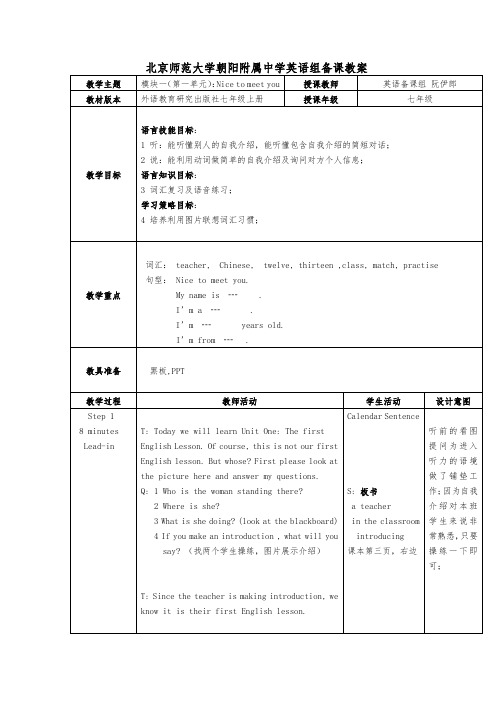
10 minutes
Step 4
Review
Homework
2 minutes
T:Today wewill learn Unit One: Thefirst English Lesson. Of course, this is not our first English lesson.But whose? First please look at the picture here and answer my questions.
1 听:能听懂别人的自我介绍,能听懂包含自我介绍的简短对话;
2 说:能利用动词做简单的自我介绍及询问对方个人信息;
语言知识目标:
3 词汇复习及语音练习;
学习策略目标:
4 培养利用图片联想词汇习惯;
教学重点
词汇: teacher, Chinese, twelve, thirteen ,class, match,practise
Q: 1 Who is the woman standing there?
2 Where is she?
3 What is she doing? (look at the blackboard)
4 If you make an introduction ,what will you say?(找两个学生操练,图片展示介绍)
match: Match the words with the pictures.(练习8标题)
Байду номын сангаасpractise singing/running/swimming
教学反思:
这节课重心放在听力上,并安排学生分角色朗读,内容比较简单,学生上课也能积极回答问题;
外研版英语七年级上册《starter module 1 unit 1 hello, miss li》优秀教案(重点资料).doc
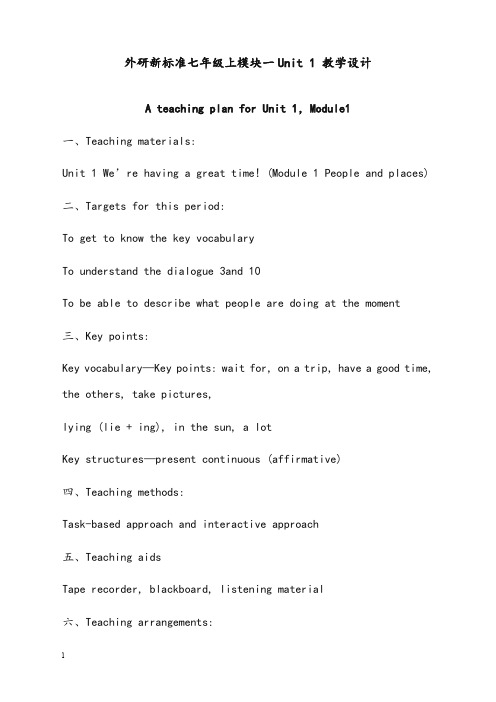
外研新标准七年级上模块一Unit 1 教学设计A teaching plan for Unit 1,Module1一、Teaching materials:Unit 1 We’re having a great time! (Module 1 People and places) 二、Targets for this period:To get to know the key vocabularyTo understand the dialogue 3and 10To be able to describe what people are doing at the moment三、Key points:Key vocabulary—Key points: wait for, on a trip, have a good time, the others, take pictures,lying (lie + ing), in the sun, a lotKey structures—present continuous (affirmative)四、Teaching methods:Task-based approach and interactive approach五、Teaching aidsTape recorder, blackboard, listening material六、Teaching arrangements:Step One Lead-in1. Ask the students who has been to the great wall and what he/ she is feeling, what they do, thus the unit is introduced.2. Match the words with the pictures in Activity 1.3. Listen and match these words in Activity 2.Step Two Presentation1. Students find out the meaning of the language points and then make sentences1) wait for 2) on a trip 3) have a good time 4) the others5) take pictures 6) lying (lie + ing) 7) in the sun 8) a lot = very much2. Show the present continuous (affirmative)I am standing on the Great wall.We are having a great time.Step Three Drilling1. Make the students discuss what the sentence structures are like. Present continuous (affirmative): be + v.-ing ( to express what people are doing now)2. Ask students to work in pairs to practice the sentence structureby making sentences according to Activity 1.Step Four Listening1. Students listen to the tape and finish Activity 4.2. Listen again and check the answers : b-d-a-e-f-g-c3. Students write full sentences for their answers in Activity 4 (Activity 5)1) Betty is talking to her mother.2) Lingling is shopping for presents.3) Daming is lying in the sun.4) Tony is eating an ice cream.5) Lingling and Betty are writing postcards.6) Wang Hui is taking photos.7) The children are enjoying the school trip.4. Students practice reading the dialogue in groupsStep Five Text explanation (Activity 3)1. another, the other, others, the others1) another 同类人或事物中的“另一个”;the other 两个人或事物中的“另一个”e.g. This pair of shoes is too small. Please show me another pair.I have two dogs. One is black and the other is white.2) others 其他的人或事物;the others 剩余的人式事物e.g. A few of them are red, others are white (另一些是白色的).A few of them are red, the others are white(剩下的是白色的).2. I’m standing on the Great Wall of China and (I’m) talking to you.And 连接两个并列成分,由于I’m相同,可以省略。
外研版七级上StarterModule1Unit1教案
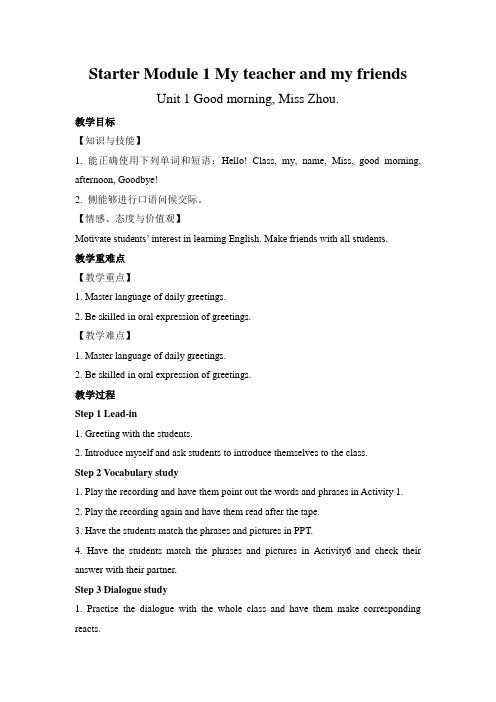
Starter Module 1 My teacher and my friendsUnit 1 Good morning, Miss Zhou.教学目标【知识与技能】1. 能正确使用下列单词和短语:Hello! Class, my, name, Miss, good morning, afternoon, Goodbye!2. 侧能够进行口语问候交际。
【情感、态度与价值观】Motivate students’ interest in learning English. Make friends with all students.教学重难点【教学重点】1. Master language of daily greetings.2. Be skilled in oral expression of greetings.【教学难点】1. Master language of daily greetings.2. Be skilled in oral expression of greetings.教学过程Step 1 Lead-in1. Greeting with the students.2. Introduce myself and ask students to introduce themselves to the class.Step 2 Vocabulary study1. Play the recording and have them point out the words and phrases in Activity 1.2. Play the recording again and have them read after the tape.3. Have the students match the phrases and pictures in PPT.4. Have the students match the phrases and pictures in Activity6 and check their answer with their partner.Step 3 Dialogue study1. Practise the dialogue with the whole class and have them make corresponding reacts.2. Have students to practise the previous dialogue with their partner.3. Work in pairs and do the Activity 7.4. Work in pairs and practise the dialogue in Activity 8. Have some of them to perform their dialogue for the whole class.Step 4 Letters study:1. Listen letters in Activity 5 and read after the tape.2. Write letters in Activity 7 and have them number the letters in Activity 7.3. Have some of them to write down letters on the blackboard and check in the class.4. Listen to the song in Activity 6 and sing.HomeworkWrite the letters from a to z.教学反思。
外研版初中英语七年级上册教案 Module 1 Unit 1 Nice to meet you
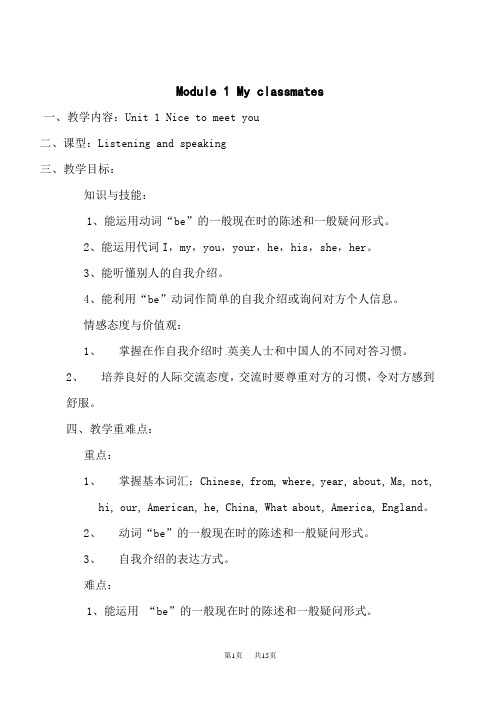
Module 1 My classmates一、教学内容:Unit 1 Nice to meet you二、课型:Listening and speaking三、教学目标:知识与技能:1、能运用动词“be”的一般现在时的陈述和一般疑问形式。
2、能运用代词I,my,you,your,he,his,she,her。
3、能听懂别人的自我介绍。
4、能利用“be”动词作简单的自我介绍或询问对方个人信息。
情感态度与价值观:1、掌握在作自我介绍时英美人士和中国人的不同对答习惯。
2、培养良好的人际交流态度,交流时要尊重对方的习惯,令对方感到舒服。
四、教学重难点:重点:1、掌握基本词汇:Chinese, from, where, year, about, Ms, not,hi, our, American, he, China, What about, America, England。
2、动词“be”的一般现在时的陈述和一般疑问形式。
3、自我介绍的表达方式。
难点:1、能运用“be”的一般现在时的陈述和一般疑问形式。
2、能听懂别人的自我介绍。
3、能利用“be”动词作简单的自我介绍或询问对方个人信息。
五、教学准备:本次课堂为听说课,主要采用互动式教学法,创设真实语境,通过个人呈现,同伴互动,小组活动等师生、生生的交流,充分体现了学生在学习过程中的主体地位,教师只是课堂的引导者,组织者和合作者,让学生在使用中学会英语,综合培养学生的英语语言运用能力。
在教学过程中,采用多媒体手段辅助教学,利用各种图片和习题任务贯穿整个教学过程。
因此,本节课需准备:PPT课件、录音机、课堂练习、奖品。
name. Now let me try toy name is Ms Mo.m 24 yearsof flags and students.them.said,at 2、Read these n ew words and practice this dialogue.A: ----Where are you from?B: ----I’m from England and I’m English. / I’m from America and I’m American.Wuhan. twelve years old. 1、Students do this exercise b ythemselves first. 2、Next check their answers withpartners and findthe originalsentences in the通过对句子正误的判断,以及从文章中找出原句这一环节,训练学生从听力材料中提取信息的能力。
外研版七年级英语上册《 Unit 1 There are thirty students in my class.》精品教案_4
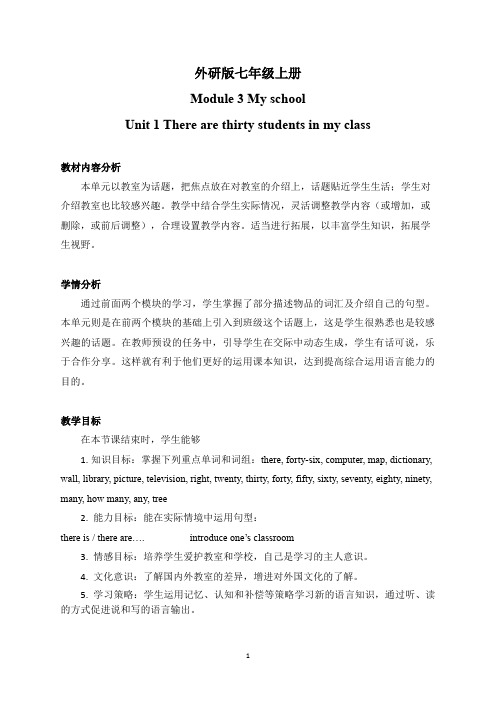
外研版七年级上册Module 3 My schoolUnit 1 There are thirty students in my class教材内容分析本单元以教室为话题,把焦点放在对教室的介绍上,话题贴近学生生活;学生对介绍教室也比较感兴趣。
教学中结合学生实际情况,灵活调整教学内容(或增加,或删除,或前后调整),合理设置教学内容。
适当进行拓展,以丰富学生知识,拓展学生视野。
学情分析通过前面两个模块的学习,学生掌握了部分描述物品的词汇及介绍自己的句型。
本单元则是在前两个模块的基础上引入到班级这个话题上,这是学生很熟悉也是较感兴趣的话题。
在教师预设的任务中,引导学生在交际中动态生成,学生有话可说,乐于合作分享。
这样就有利于他们更好的运用课本知识,达到提高综合运用语言能力的目的。
教学目标在本节课结束时,学生能够1.知识目标:掌握下列重点单词和词组:there, forty-six, computer, map, dictionary, wall, library, picture, television, right, twenty, thirty, forty, fifty, sixty, seventy, eighty, ninety, many, how many, any, tree2. 能力目标:能在实际情境中运用句型:there is / there are….introduce one’s classroo m3. 情感目标:培养学生爱护教室和学校,自己是学习的主人意识。
4. 文化意识:了解国内外教室的差异,增进对外国文化的了解。
5. 学习策略:学生运用记忆、认知和补偿等策略学习新的语言知识,通过听、读的方式促进说和写的语言输出。
教学重难点1.重点:There is a/ an….There are….2. 难点:运用there be 句型和描述自己的理想教室教学工具和方法运用多媒体促进任务型教学的生成、以听促说教学的实现。
外研版七年级英语上册 七上Module1 备课
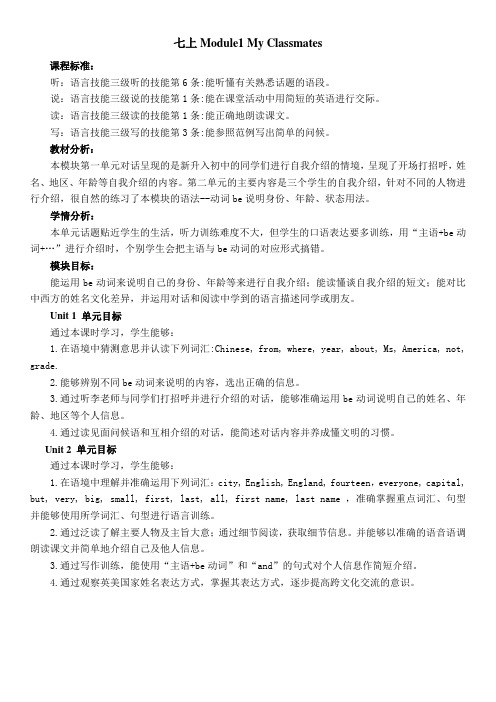
七上Module1 My Classmates课程标准:听:语言技能三级听的技能第6条:能听懂有关熟悉话题的语段。
说:语言技能三级说的技能第1条:能在课堂活动中用简短的英语进行交际。
读:语言技能三级读的技能第1条:能正确地朗读课文。
写:语言技能三级写的技能第3条:能参照范例写出简单的问候。
教材分析:本模块第一单元对话呈现的是新升入初中的同学们进行自我介绍的情境,呈现了开场打招呼,姓名、地区、年龄等自我介绍的内容。
第二单元的主要内容是三个学生的自我介绍,针对不同的人物进行介绍,很自然的练习了本模块的语法--动词be说明身份、年龄、状态用法。
学情分析:本单元话题贴近学生的生活,听力训练难度不大,但学生的口语表达要多训练,用“主语+be动词+…”进行介绍时,个别学生会把主语与be动词的对应形式搞错。
模块目标:能运用be动词来说明自己的身份、年龄等来进行自我介绍;能读懂谈自我介绍的短文;能对比中西方的姓名文化差异,并运用对话和阅读中学到的语言描述同学或朋友。
Unit 1 单元目标通过本课时学习,学生能够:1.在语境中猜测意思并认读下列词汇:Chinese, from, where, year, about, Ms, America, not, grade.2.能够辨别不同be动词来说明的内容,选出正确的信息。
3.通过听李老师与同学们打招呼并进行介绍的对话,能够准确运用be动词说明自己的姓名、年龄、地区等个人信息。
4.通过读见面问候语和互相介绍的对话,能简述对话内容并养成懂文明的习惯。
Unit 2 单元目标通过本课时学习,学生能够:1.在语境中理解并准确运用下列词汇:city, English, England, fourteen,everyone, capital, but, very, big, small, first, last, all, first name, last name ,准确掌握重点词汇、句型并能够使用所学词汇、句型进行语言训练。
外研七年级上starter module 1 教案
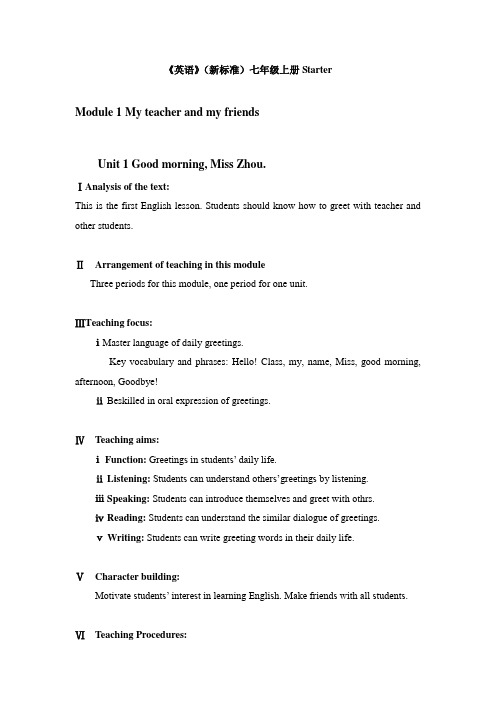
《英语》(新标准)七年级上册StarterModule 1 My teacher and my friendsUnit 1 Good morning, Miss Zhou.ⅠAnalysis of the text:This is the first English lesson. Students should know how to greet with teacher and other students.ⅡArrangement of teaching in this moduleThree periods for this module, one period for one unit.ⅢTeaching focus:ⅰMaster language of daily greetings.Key vocabulary and phrases: Hello! Class, my, name, Miss, good morning, afternoon, Goodbye!ⅱBeskilled in oral expression of greetings.ⅣTeaching aims:ⅰ Function: Greetings in students’ daily life.ⅱ Listening: Students can understand others’greetings by listening.ⅲ Speaking: Students can introduce themselves and greet with othrs.ⅳ Reading: Students can understand the similar dialogue of greetings.ⅴ Writing: Students can write greeting words in their daily life.ⅤCharacter building:Motivate students’ interest in learning English. Make friends with all students.ⅥTeaching Procedures:Part I: Lead in:Step 1: Greeting with the students.Step 2: Introduce myself and ask students to introduce themselves to the class.Part II:Vocabulary study:Step 1:Play the recording and have them point out the words and phrases in Activity 1.Step 2: Play the recording again and have them read after the tape.Step 3: Have the students match the phrases and pictures in PPT.Step 4: Have the students match the phrases and pictures in Activity6 and check their answer with their partner.Part Ⅲ: Dialogue study:Step 1: Practise the dialogue with the whole class and have them make corresponding reacts.Step 2: Have students to practise the previous dialogue with their partner.Step 3: Work in pairs and do the Activity 7.Step 4: Work in pairs and practise the dialogue in Activity8. Have some of them to perform their dialogue for the whole class.Part Ⅳ:Letters study:Step 1: Listen letters in Activity 5 and read after the tape.Step 2: write letters in Activity 7 and have them number the letters in Activity 7.Step 3: Have some of them to write down letters on the blackboard and check in the calss.Step 4: Listen the song in Activity 6 and sing.Unit 2 Good morning. I’m Chen Zhong.ⅠAnalysis of the text:In this text students will learn how to introduce themselves to others, and make relative greetings.ⅡArrangement of teaching in this moduleThree periods for this module, one period for one unit.ⅢTeaching focus:ⅰMaster language of self-introduction and greetings in the situation of first meeting.Key vocabulary and phrases: Good morning. What’s your name? How are you? Fine, thanks.ⅱBeskilled in oral expression ofself-introduction and greetings in the situation of first meeting.ⅣTeaching aims:ⅰ Function:Self-introduction and greetings in the situation of first meeting.ⅱListening: Students can understand others’introduction andgreetings by listening.ⅲ Speaking: Students can introduce themselves and greet with othrs.ⅳ Reading: Students can understand the similar dialogue of self-introduction and greetings.ⅴ Writing: Students can write their self-introduction.ⅤTeaching Procedures:Part I:Lead in:Step 1: Review the greeting phrases in the previous period by having the whole class play the dialoge in real situation .Step 2: Ask students to introduce themselves to the class.Part II:Vocabulary study:Step 1:Play the recording and have them point out the words and phrases in Activity 1.Step 2: Play the recording again and have them read after the tape.Step 3: Have the students match the sentences in Activity 3 and check their answer with their partner.Step 4: Listen the dialogue in Activity3 and check their answes.Step 5: Write the sentences in Activity 5.Part Ⅲ: Dialogue study:Step 1:Listen sentences in Activity 4 and have them number the sentences in Activity4.Step 2: Teacher practise a dialogue with single student as follows:Teacher: Good morning.Student: Good morning.Teacher: What’s your name?Student: My name is…Teacher: How are you?Student: Fine, thanks.Step3: Work in pairs and practise the dialogue in Activity6. Have some of them to perform their dialogue for the whole class.Unit 3 This is my friend.ⅠAnalysis of the text:In this text students will learn how to introduce their friends and family members to others.ⅡArrangement of teaching in this moduleThree periods for this module, one period for one unit.ⅢTeaching focus:ⅰMaster language of introducing friends and famliy to others.Key vocabulary and phrases: friend, teacher, father, mother, This i s… , meet,time,go, now, bye, tomorrow.ⅱBeskilled in oral expression of introducing someone to others.ⅣTeaching aims:ⅰ Function:Introduction of friends and family members.ⅱ Listening: Students can understand others’ introduction of someone.ⅲ Speaking: Students can introduce their friends and family members to others.ⅳ Reading: Students can understand the similar dialogue of introducing others.ⅴ Writing: Students can write the introduction of their friends and their family members.ⅤTeaching Procedures:Part I:Lead in:Step 1: Review the greeting phrases in the previous period by having the whole class play the dialoge in real situation .Step 2: Ask students to introduce themselves to the class.Part II:Vocabulary study:Step 1:Play the recording and have them point out the words and phrases in Activity 1.Step 2: Play the recording again and have them read after the tape.Step 3: Have the students match the sentences in Activity 3 and check their answer with their partner.Step 4: Listen the dialogue in Activity 4 and check their answers.Step 5: Write the sentences in Activity 5.Part Ⅲ: Dialogue study:Step 1:Listen sentences in Activity 6 and have them number the pictures in Activity 6.Step 2: Work in group of 4 and fill the blanks in Activity7, then have some groups of them to perform the dialoge for the whole class.Step3: Work in group of 3, and introduce your partner to the other student. Have some groups to perform the dialoge for the whole class.。
- 1、下载文档前请自行甄别文档内容的完整性,平台不提供额外的编辑、内容补充、找答案等附加服务。
- 2、"仅部分预览"的文档,不可在线预览部分如存在完整性等问题,可反馈申请退款(可完整预览的文档不适用该条件!)。
- 3、如文档侵犯您的权益,请联系客服反馈,我们会尽快为您处理(人工客服工作时间:9:00-18:30)。
外研版英语七年级上册第一单元
Unit 1
要点精讲
1.meet 认识;遇见
First 第一
English 英语
Lesson (一节)课
Class 班级
Student 学生
Miss 女士;小姐(对未婚女性)
Twelve 十二
Year ……岁
Thirteen 十三
Too 也
From 从……来
Close 关闭
Open 打开
Match 相称;匹配
Write 写
Practise 练习
2.I’m from Wuhan.
我来自武汉。
(我是武汉人)
这里be from表示“来自哪里”、“从哪
里来的”或“是哪里人”。
eg: They are from England.
他们是从英国来的。
(他们是英国人)
如果不强调从哪里来,只是要说明身
份,也可以说:
He’s a Beijinger.他是北京人。
They’re English.他们是英国人。
3.I’m a student and I’m twelve years old.
我是一名学生,十二岁了。
这里…years old 用来表述年龄,表示
“……岁”。
有时,years old可以省略。
只用数字表达年龄即可。
eg: My sister is five.
我妹妹五岁了。
4.英语里经常把两个或更多意思上关系很
紧密的句子合并成一个句子,形成并列
句。
并列句中的分句可以用and连接。
eg: He’s English and he’s in Class One.
他是英国人,他在一班。
5.I’m from China and I’m Chinese.
我来自中国,我是中国人。
在表达来自某个国家时,要使用国名。
如:China, Canada等等。
如果要强调
是某国人时,则要用其形容词形式。
如:Chinese, English等等。
另:be from=come from
eg: Tom is from America.=Tom comes
from America.汤姆来自美国。
典型例题
【例1】---Hi, Tony. -----______.
A.How are you?
B.Good afternoon,Frank.
C.Hi, Bob.
D.Good morning,Kate.
【答案】C
【解析】Hi是问候语的标志,根据上下句,“Hi, Tony”是见面打招呼的用语,那么答句也与之相同
【例2】----This is ______ Li, he is my English teacher.
A.Mr
B.Mrs
C.Ms
D. Miss
【答案】A
【解析】根据句中的“he”,可以知道李老师是男性,称呼男性应用“Mr”。
Unit 2
要点精讲
1.City n. 城市
England n. 英国;英格兰
English adj. 英国的
Fourteen num. 十四
Eleven num. 十一
twenty-nine num. 二十九
fifty num. 五十
2.I’m in Class One with Daming and
Lingling.
我和大明、玲玲都在(1)班。
这里with表示“和……在一起”。
Shanshan is in London with her
parents.
珊珊和她的父母住在伦敦。
3.What’s your name?
My name is…
I’m 13 years old.
I’m from Shanghai.
Where are you from?
I’m from China. I’m Chinese.
We’re good friends.
Lingling isn’t my friend.
They aren’t my classmates.
family name and given name
How old is he?
典型例题
【例1】----Nice to meet you! ----___________.
A.I’m fine
B.How are you
C. Nice to meet you, too.
D.How do you do
【答案】C
【解析】“Nice to meet you,”见到你很高兴,是礼貌用语的固定用法,它的答句也是“Nice to meet you, too”。
【例2】_____ is Kate Green, she is my daughter.
A.She
B.This
C.He
D.That
【答案】B
【解析】介绍人物时“this”表示这是,根据句意,这是格林凯特,她是我的妹妹。
Unit 3
要点精讲
1.他们来自中国,他们是中国人。
They’re from China and they’re Chinese.
2.汤姆来自英国,他是英国人。
Tom is from England and he is English.
3.你们来自哪里?
Where’re you from? / Where do you come from?
4.上海是一个大城市吗?
Is Shanghai a big city?
5.玲玲是我的第一个好朋友。
Lingling is my first good friend.
6.看书read books
坐下sit down
起立stand up
在黑板上写write on the blackboard
姓氏family name
名字given name
在英语里in English
在汉语里in Chinese
典型例题
【例1】Hi. My name is Liu Dong. I’m ___, I’m from ____.
A . China, Chinese B. Chinese, China C. Chinese, china
【答案】B
【解析】Chinese 代表:中国的,中华的,中国人,华人,中国人的,华人的,中国话,汉语,中文等等。
China 则是中国的意思。
【例2】Tom and I are in the same class.
----- They are in ____.
A . class one B. Class One C. Class one
【答案】B
【解析】Class是名词n.,表示班级;年级的意思,在表达特定班级的时候,开头字母要大写。
